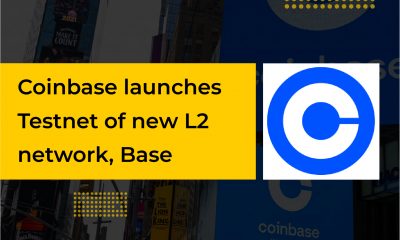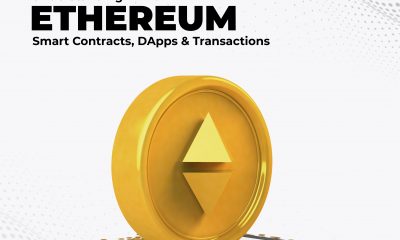Education
What are Decentralized Apps?

Decentralized applications, or DApps for short, are software programs that run autonomously and securely on a decentralized blockchain network. Unlike traditional apps that require centralized servers to function effectively, DApps operate without any central point of control.
A distinguishing feature of these types of applications is their use of smart contracts – self-executing pieces of code stored within the blockchain network itself. Smart contracts facilitate automated transactions between parties by enforcing predetermined rules written into the code.
DApp users can interact with them in various ways such as sending/receiving tokens or accessing specific services provided by the application using cryptocurrency wallets connected through an interface layer like MetaMask. Decentralized applications run on a peer-to-peer network, which means that they are not controlled by any single entity or authority. This makes DApps more transparent, secure, and resistant to censorship and hacking attempts compared to traditional centralized applications.
Since the data is stored on a decentralized blockchain network rather than in one central place, it becomes virtually impossible for anyone – including hackers – to alter or delete information without consensus from all participants of the network. The transparency aspect of DApps ensures accountability as everyone can see what’s happening inside them at any given time; no hidden transactions exist within these networks. The beauty of DApps is they provide an alternative to traditional centralized systems by enabling peer-to-peer transactions without the need for intermediaries. This not only eliminates middlemen but also enhances security and transparency while reducing costs.
Financial services remain one of the most popular use cases for decentralized applications as people seek alternatives to legacy banking structures. However, there’s no limit to what can be done with this technology. From social media networks designed around privacy and user control to gaming ecosystems where users own their in-game assets completely; everything is possible via these next-generation apps built upon blockchain architecture.
For instance: imagine being able to borrow money directly from other individuals you’ve never met before through a platform secured by cryptography. These types of Decentralised Lending Platforms could transform how we borrow money today!
Decentralized applications, or DApps, have been made possible through the advent of blockchain technology. These apps are typically open-source software programs that run on a decentralized network such as Ethereum. Cryptocurrency tokens can be used within these networks to facilitate transactions in a trustless manner without needing intermediaries like banks. This makes it easier for users to transact with each other across borders and at any time they choose.
Closing thoughts
Distributed Applications (or DApps) are a new paradigm for building applications that offer several advantages over traditional centralized apps. By using blockchain technology, they can provide unprecedented levels of transparency, security, and accessibility. Because they don’t rely on central servers or intermediaries to function, DApps eliminate single points of failure in their infrastructure. This makes them much more resilient against cyber-attacks or other forms of disruption than traditional systems.
Furthermore, because all transactions within a given DApp are transparently recorded on an immutable ledger shared among network nodes – usually via smart contracts – there is no need for third-party verification services such as notary publics which greatly reduces transaction costs while increasing trust between parties doing business with each other.
The ecosystem is evolving beyond cryptocurrencies like Bitcoin into newer technologies like Ethereum’s Smart Contracts platform, Solana, Aptos, Polygon, BNB Chain etc. We can expect increasingly sophisticated types of decentralized application use cases emerging across industries ranging from finance/banking/insurance companies right up to medical & healthcare providers. These will prove highly transformative due largely thanks to their ability to create greater efficiencies by bypassing legacy gatekeepers who have traditionally limited access to data flows.

















Pingback: What are Decentralized Apps? | CryptoTvplus: DeFi, NFT, Bitcoin, Ethereum Altcoin, Cryptocurrency & Blockchain News, Interviews, Research, Shows – BTC Noon
Pingback: What are Decentralized Apps? by Marvelous Akpere – CryptoTvplus Events: NFT, DeFi, Bitcoin, Ethereum, Altcoin Events
Pingback: What are Decentralized Apps? | CryptoTvplus: DeFi, NFT, Bitcoin, Ethereum Altcoin, Cryptocurrency & Blockchain News, Interviews, Research, Shows - Crypto Bandit365
Pingback: What is fiat currency? | CryptoTvplus: DeFi, NFT, Bitcoin, Ethereum Altcoin, Cryptocurrency & Blockchain News, Interviews, Research, Shows – The Oceania Times
Pingback: What is an IDO? | CryptoTvplus: DeFi, NFT, Bitcoin, Ethereum Altcoin, Cryptocurrency & Blockchain News, Interviews, Research, Shows
Pingback: What is KYC & why it is important in crypto? – MarketFools.com
Pingback: What is KYC & why it is important in crypto? - WealthyMotivesCrypto.com
Pingback: What is an IDO? | CryptoTvplus: DeFi, NFT, Bitcoin, Ethereum Altcoin, Cryptocurrency & Blockchain News, Interviews, Research, Shows - Crypto Gist
Pingback: What is a DAO? | CryptoTvplus: DeFi, NFT, Bitcoin, Ethereum Altcoin, Cryptocurrency & Blockchain News, Interviews, Research, Shows
Pingback: Huobi Partners with Gala Games for new endeavours | CryptoTvplus: DeFi, NFT, Bitcoin, Ethereum Altcoin, Cryptocurrency & Blockchain News, Interviews, Research, Shows
Pingback: Huobi Partners with Gala Games for new endeavours - WealthyMotivesCrypto.com
Pingback: Huobi Partners with Gala Games for new endeavours – TheDigitalAssetTimes.info